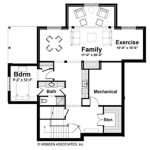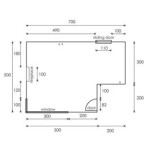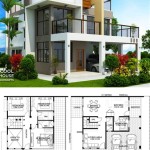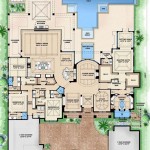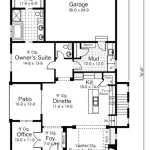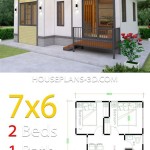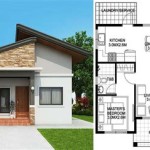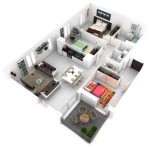Simple House Plan Design With Dimensions: 2 Bedroom
The demand for simple, efficient, and affordable housing continues to rise. A crucial aspect of addressing this need involves the design of functional and compact homes. This article explores the elements that contribute to a well-designed, simple house plan with dimensions specifically focusing on a two-bedroom layout. Understanding spatial relationships, optimizing square footage, and considering cost-effective construction techniques are all paramount in creating a practical and appealing living space.
Designing a two-bedroom home requires a careful balance between providing comfortable living spaces and maximizing efficiency. It often involves a focus on open-plan living, strategic storage solutions, and minimizing wasted space. Detailed dimensions are essential from the outset to ensure accurate material estimations, efficient construction, and comfortable occupancy. The following sections will delve into key considerations for designing a simple, two-bedroom house plan.
Optimizing Space in a 2-Bedroom House Plan
The key to a successful simple house plan lies in the effective utilization of available space. Every square foot counts, and a well-thought-out design minimizes hallways and maximizes the use of communal areas. In a two-bedroom house, optimizing space is particularly important, as the overall footprint is typically smaller than that of larger homes.
One effective strategy is to adopt an open-plan living design. This combines the living room, dining area, and kitchen into a single, cohesive space. Open-plan living creates a feeling of spaciousness and allows for better natural light distribution. It also fosters a more social environment, as family members can interact more easily while engaging in different activities.
Careful consideration should be given to the placement of furniture and appliances within the open-plan area. Dimensions of furniture pieces must be considered to ensure they fit comfortably and do not obstruct movement. Strategic placement of furniture can also help to define distinct zones within the open-plan space. For example, a strategically placed sofa or dining table can create a visual separation between the living and dining areas.
Another important aspect of space optimization is the incorporation of multi-functional furniture. Items such as sofa beds, storage ottomans, and folding tables can serve multiple purposes, reducing the need for additional furniture and freeing up valuable floor space. These types of furniture are particularly useful in smaller two-bedroom homes where space is at a premium.
Storage solutions are also crucial for maximizing space. Built-in storage, such as wardrobes, shelving units, and under-stair storage, can help to keep clutter at bay and create a more organized living environment. Vertical storage, such as tall bookshelves or cabinets, can also be used to maximize storage capacity without taking up too much floor space.
The dimensions of closets and storage spaces should be carefully considered. Aim for adequate depth and width to accommodate clothing, linens, and other household items. Strategically placed closets near entrances and bedrooms can also help to keep frequently used items easily accessible.
Hallways, often considered wasted space, should be minimized wherever possible. Consider designing the house with fewer, wider hallways rather than multiple narrow hallways. Open-plan living can also help to reduce the need for hallways by creating more direct connections between different areas of the house. If hallways are necessary, ensure they are wide enough to allow for comfortable movement and passage of furniture.
Finally, take advantage of natural light to make the house feel more spacious. Large windows and skylights can bring in ample natural light, making the rooms feel brighter and more open. Proper window placement can also minimize the need for artificial lighting during the day, saving energy and reducing electricity bills.
Understanding Dimensions and Layout in a 2-Bedroom House
Accurate dimensions are fundamental to a successful house plan. They dictate the size and arrangement of rooms, the placement of doors and windows, and the overall flow of the house. In a two-bedroom house, careful consideration of dimensions is paramount to ensure that each room is functional and comfortable.
The first step in determining dimensions is to establish the overall footprint of the house. This will depend on factors such as the size of the lot, zoning regulations, and budget constraints. Once the overall footprint is determined, the space can be allocated to different rooms and areas within the house.
Bedrooms are typically the largest rooms in a two-bedroom house. The master bedroom should generally be larger than the second bedroom, providing ample space for a bed, dresser, and other furniture. Consider the dimensions of a standard bed (e.g., queen or king size) when planning the bedroom layout. Allow for adequate space around the bed for comfortable movement and access to closets and dressers.
The second bedroom can be smaller than the master bedroom, but it should still be large enough to accommodate a bed, desk, and closet. This room can serve as a guest room, home office, or children's bedroom. Consider the specific needs of the occupants when determining the dimensions of the second bedroom.
The bathroom is another important space to consider. A full bathroom typically includes a toilet, sink, and shower or bathtub. A half bathroom (also known as a powder room) typically includes a toilet and sink. The dimensions of the bathroom should be adequate to comfortably accommodate these fixtures and allow for easy movement.
The kitchen is the heart of the home, and its dimensions should be carefully considered. The kitchen layout will depend on factors such as the size of the house, the style of cooking, and the number of occupants. Common kitchen layouts include the galley kitchen, the L-shaped kitchen, and the U-shaped kitchen. Each layout has its own advantages and disadvantages in terms of space efficiency and functionality.
The living room should be large enough to accommodate comfortable seating areas and allow for easy circulation. Consider the placement of furniture, such as sofas, chairs, and coffee tables, when determining the dimensions of the living room. The living room should also have adequate natural light and ventilation.
The dining area can be either a separate room or incorporated into the open-plan living area. The dimensions of the dining area should be large enough to accommodate a dining table and chairs, as well as allow for easy movement around the table. Consider the number of people who will typically be using the dining area when determining its size.
Finally, consider the dimensions of hallways, entryways, and other transitional spaces. These spaces should be wide enough to allow for comfortable movement and passage of furniture. Minimize the length of hallways to avoid wasting space.
Cost-Effective Construction Techniques for Simple House Plans
Building a house can be a significant investment, and it is important to consider cost-effective construction techniques to keep expenses under control. Choosing the right materials, simplifying the design, and minimizing waste can all contribute to a more affordable building project. Selecting the right construction method is also important.
One of the most effective ways to reduce construction costs is to simplify the design of the house. Avoid complex architectural features, such as elaborate rooflines, curved walls, and intricate trim. A simple, rectangular house is generally more affordable to build than a more complex design.
Choosing cost-effective building materials is also crucial. Opt for locally sourced materials whenever possible, as this can reduce transportation costs. Consider using sustainable materials, such as reclaimed wood, recycled steel, and bamboo flooring, which can be both environmentally friendly and cost-effective.
Concrete blocks are often a cost-effective alternative to brick. Wood is a more common choice for residential construction and is very cost-effective, especially if the home is being built somewhere where wood is plentiful. Consider metal studs in place of wood.
Another important aspect of cost-effective construction is minimizing waste. Careful planning and accurate material estimations can help to reduce waste during the building process. Recycling and reusing materials can also help to reduce waste and save money.
Consider using pre-fabricated components, such as trusses, wall panels, and roof panels. These components are manufactured off-site and can be assembled quickly and easily, reducing construction time and labor costs. Pre-fabricated components can also be more accurate and consistent than on-site construction, resulting in a higher-quality finished product.
Another way to reduce labor costs is to use fewer skilled trades. Simple designs with fewer complex details require less skilled labor, which can translate into significant savings. Consider using materials and techniques that are easy to install, such as pre-finished flooring and drywall.
Proper insulation is essential for energy efficiency and can also help to reduce heating and cooling costs. Insulate walls, ceilings, and floors properly to minimize heat loss in the winter and heat gain in the summer. Consider using energy-efficient windows and doors to further reduce energy consumption.
Finally, consider the landscaping when planning the construction budget. Simple landscaping, such as grass and shrubs, is generally more affordable than elaborate landscaping features, such as patios, decks, and water features. Choose drought-tolerant plants to minimize the need for watering and reduce water bills.

5 Small And Simple 2 Bedroom House Designs With Floor Plans

Extremely Gorgeous 2 Bedroom House Plans Pinoy Designs

Two Bedroom Small House Design Shd 2024030 Pinoy Eplans

Unique 2 Bedrooms House Plans With Photos New Home Design De

Simple 2 Bedroom House Plan 21271dr Architectural Designs Plans

Free Simple Two Story House Plans

12 Simple 2 Bedroom House Plans With Garages Houseplans Blog Com

Two Bedrooms House Floor Plan Template

Plan 76346 Modern Style With 2 Bed 1 Bath

Low Budget Modern 2 Bedroom House Design In Taiwo Salam Co Properties Limited
Related Posts

